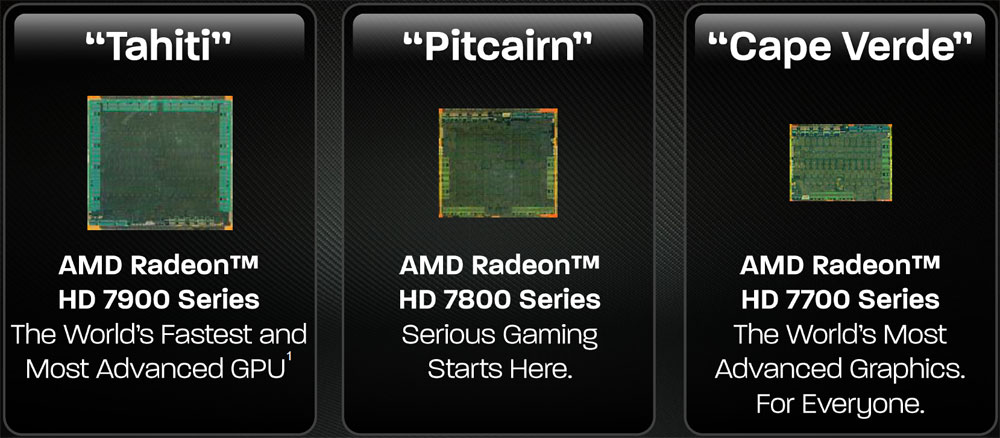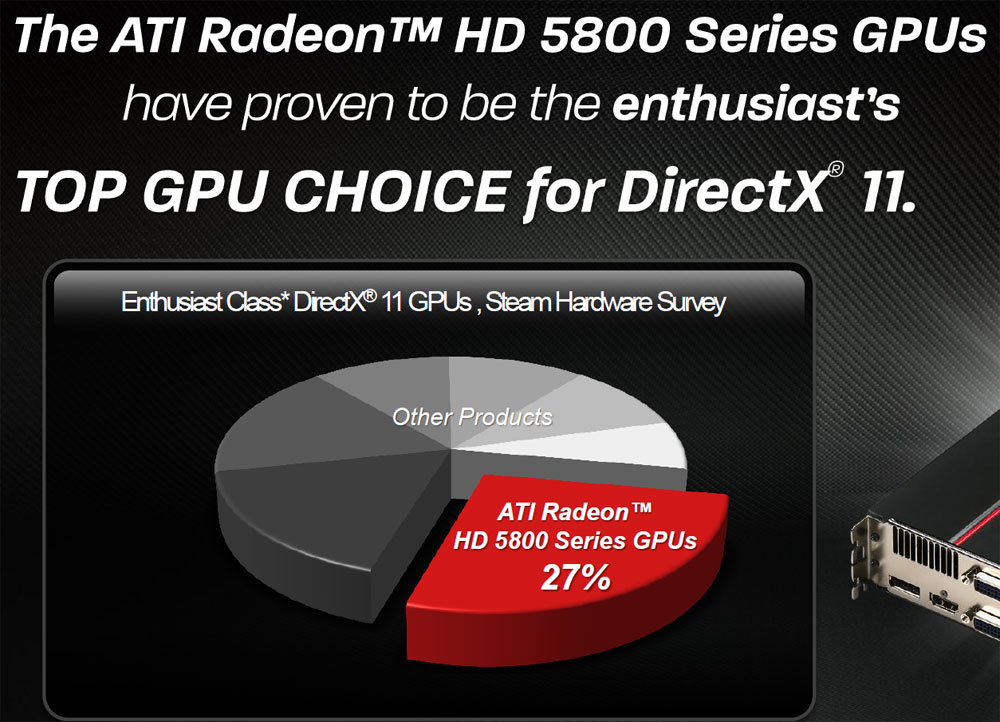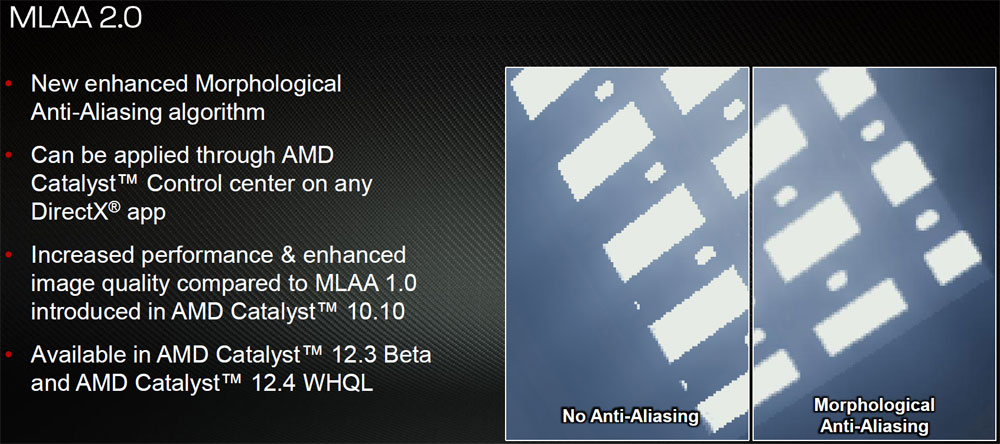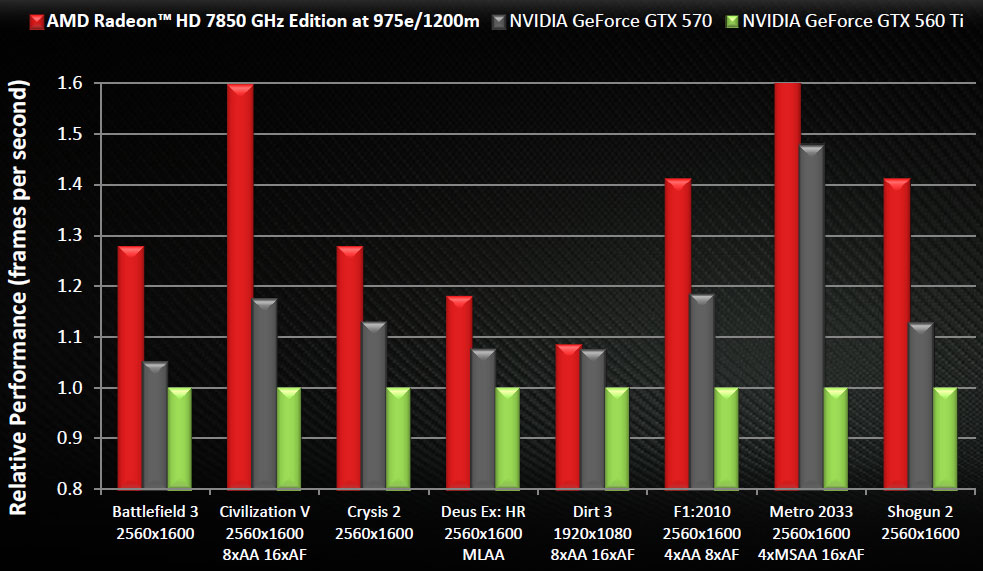Completing the Family
Pitcairn is here and the entire AMD Radeon HD 7000 series is now laid out before us. How do the 7870 and 7850 perform?
When we went to Austin, Texas to sit with AMD and learn about the Radeon HD 7900 series of cards for the first time, an interesting thing happened. While the official meeting was about the performance of the Radeon HD 7970 and HD 7950, when things started to settle several AMD employees couldn’t help but discuss Cape Verde (7700-series) and Pitcairn (7800-series) GPUs. In particular, the HD 7800 cards were generating a lot of excitement internally as a spiritual follow up to the wildly successful HD 5800 and HD 5700 series of cards in terms of price and performance characteristics.
So while the Radeon HD 7970 and HD 7950 are being labeled as the world’s fastest GPUs, and the Radeon HD 7700 is the fastest GPU for everyone, the HD 7800s are where many of our readers will look when upgrading their machines while staying within a budget.
Be sure to check out our video review posted here and then continue on to our full, written review for all the benchmarks and analysis!!!
Continue reading our review of the Radeon HD 7870 and HD 7850 Graphics Cards!!
AMD Pitcairn – the Radeon HD 7800 series GPU
To complete the family of Radeon HD 7000 series of GPUs (still pending the dual-GPU Radeon HD 7990), the Pitcairn GPU brings the same Graphics Core Next architecture we first saw in the HD 7900 into the $250-350 price rage. If you haven’t read about the changes and updates in AMD’s latest graphics architecture you should really stop by the first couple of pages of our HD 7970 review to get the necessary back story before moving on. Don’t worry, I’ll wait for you finish…
As I mentioned above, AMD really is hoping to duplicate the success of the Radeon HD 5800/5700 cards with the HD 7800 series. According to the Steam Hardware Survey from January the AMD Radeon HD 5800 series of cards make up 27% of the total DX11-capable hardware on users systems. That is pretty significant and simply put AMD as a company needs a runaway success like that once again.
The Pitcairn GPU that is the base for the HD 7870 and HD 7850 graphics cards is cut down from the Tahiti GPU and includes 20 Compute Units, 1280 stream processors, a 256-bit memory bus and quite a bit more. That is roughly 65% of the theoretical horsepower of the HD 7970 card found on the HD 7870 for about 65% of the cost.
Unlike the HD 7700 cards, the HD 7800s will keep the dual geometry engines, rasterizers and asynchronous compute engines. By keeping a nearly full-size 256-bit memory bus the HD 7800s should see much less memory performance penalty as well (5.5 Gbps versus 4.8 Gbps).
In our image above you can see a comparison of the three Southern Islands GPUs starting with the Tahiti (largest), going down to Pitcairn (middle) and completed with Cape Verde (smallest). Pitcairn has 2.8 billion transistors and is of course built on the same 28nm process technology that brings tremendous power benefits but apparently a lot of production and inventory questions as well. The die size as reported by AMD is 212 mm2.
AMD is definitely trying to capture that large audience that bought into the Radeon HD 5800 cards – these types of comparisons will be showing up EVERYWHERE and try to illustrate the architecture and performance differences you would see by moving from Evergreen to Southern Islands.
There is a software change that will come with the HD 7800 release: MLAA 2.0. This update will be available with the Catalyst 12.3 beta driver and then all drivers after that. The good news is that this performance and quality improvement will be backwards compatible with all the 7000-series and 6000-series cards from AMD.
The Radeon HD 7870 GHz Edition (pictured) above will retail for somewhere around $350 and will use the full Pitcairn GPU with 1280 stream processors. As the suffix to the card indicates the reference clock of this part is 1000 MHz with a memory clock of 1200 MHz running on a full 2GB of frame buffer. The typical board power for the HD 7870 is only 175 watts though we will see that it can easily prove itself more power efficient than anything NVIDIA currently has on the market.
Even though the reference clock is 1 GHz, AMD wants everyone to know that these cards should be able to overclock even higher with very little additional effort. The graph above shows the Radeon HD 7870 running at 1200 MHz core clock and 1375 MHz memory clock.
Here are the base specs for the Radeon HD 7850, planned to be sold at $250 or so, that includes 16 Compute Units and 1024 stream processors. The clock speeds are quite a bit lower at 860 MHz core though it does keep the same 1200 MHz memory clock with the same 2GB frame buffer. Typical power usage drops to around 130 watts here.
I really feel that the 2GB frame buffer on cards as low as $249 is a big differentiating feature between the Radeon HD 7800/7900 cards and current lineup of NVIDIA GeForce offerings. The high end GTX 580 only has 1.5GB of memory unless you purchase a special edition model and with cards like the GTX 560 Ti only getting 1GB, there are some interesting issues that crop up in games like Battlefield 3.
In a similar fashion to the overclocking capability of the HD 7870, AMD was touting the overclocking capability of the HD 7850 as well, hitting as high as 975 MHz core. In my testing we actually saw the HD 7850 hit as high as 1050 MHz!
Here we have the detailed table of specifications on these two new cards so you see them side by side. While the Radeon HD 7870 will have 80 texture units the HD 7850 will drop to 64 of them; both cards have 32 ROPs though for render backend performance.



















I think I found my new
I think I found my new upgrade…
I think you will not be
I think you will not be alone.
Definitely, you won’t be
Definitely, you won’t be alone. I was about to build my rig with a GTX 560 Ti to ass another one later. But now, I’ll wait for 7870 wich is very close to GTX 570 but whit much lower power consumption, making it possible to Crossfire on my TX750 PSU.
Definitely, you won’t be
Definitely, you won’t be alone. I was about to build my rig with a GTX 560 Ti to ass another one later. But now, I’ll wait for 7870 wich is very close to GTX 570 but whit much lower power consumption, making it possible to Crossfire on my TX750 PSU.
Thanks for that last page
Thanks for that last page Ryan, I enjoyed seeing the spread of the 7000 series cards and it will really make me think when I do my birthday upgrade. So far it’s either the 7950 or the 7870.
Tough choice.
Yeah, I thought seeing the
Yeah, I thought seeing the data in that way was kind of interesting, even as someone who has tested each of them.
It started with i – Phone and
It started with i – Phone and it has now gone after i –
Pad 2; the reason- insufficient availability. Virus Barrier X5 is often a popular virus scanner designed for Mac
computers. Typically, the My Documents folder could be the best someone to use.
Here is my page; the pirate bay (http://www.breakedu.com/)
I liked the last page’s
I liked the last page’s comparison as well. Shows the spread of the 7K family.
I was hoping for a little more out of the 7870 i think. Appears to be about on par with the gtx570 which can be had for $315 after rebate. I can wait for Kepler to drop and competition to bring the 7K series prices down before i make a decision on upgrading.
Confused as to why nearly
Confused as to why nearly everyone including pcper didn’t show relative benchmarks again 7970 and 7950.
Did you skip the last page?
Did you skip the last page? Entire 7K series comparison.
Yeah I did actually.
Thanks
Yeah I did actually.
Thanks for pointing that out, shame on me for thinking pcper would drop the ball like other sites have.
Cheers
What he said. Thanks for
What he said. Thanks for reading!
I’m a little pissed now,
I’m a little pissed now, based on the price/performance aspect. I just bought a 6970 this month!
Those benchmarks made the 560 Ti look like trash…
I like the new office, and the bins of graphics cards.
But the big question is…
But the big question is… how much did you pay for said 6970? While the 7870 is faster overall, it still isn’t available and it will be at least $359 once it hits (and depending on demand, might reach a little higher). If you got a 6970 for $330 or less, then I would say it is still a good buy.
I just got this 6970
I just got this 6970 Lightning, for around 359$. Its is now “Deactivated” on Newegg…
No second card for me it seems….
I’m not too upset since my card came overclocked, and i can clock it higher. It is still a great card.
Though I kinda wish AMD stopped selling these cards so close to release, or dropped the price more.
I got it less than 3 weeks ago, i kinda feel like a jackass now…
Well… that’s still an
Well… that’s still an awesome card. Not a terrible price either for what you end up getting. That thing is a beast…
I’m not disappointed with the
I’m not disappointed with the card, the custom cooler keeps it cool a 60C on full load @ 940MHz. So some more OCing headroom exists. It is a beast.
I still wish AMD stopped selling cards that are under-powered compared to the new versions at stock clocks. (6970 vs 7970 vs 7870) Or at least some hint that these cards are going to be replaced in a big way, not just a incremental update like i7 1st gen vs i7 2nd gen. Where the advantages come from the process change not an entire new architecture. I’m just being bitter, don’t mind me.
Or if you got a 6950 2gb for
Or if you got a 6950 2gb for $250 and unlocked it to 6970 even better deal 🙂
How about a 6950 for $200 and
How about a 6950 for $200 and unlock it to a 6970? New Egg has one for only 2 bills this weekend.
This generation AMD are first
This generation AMD are first to release the cards but will suffer in the end coz the prices are inflated. Especially, the release of kepler will highlight the point. this gen goes to nvidia and there are no 2 ways abt it. consider the fact that the 7850 is abt 10% faster than gtx 560 ti, a card launched over 14 months b4. Thats not impressive. The price perfrmance thing will be the biggest downer for AMD when kepler comes out. AMD really needs to reduce the prices. and they will wen kepler is released, but those who buy the cards now will be weeping. SO i say better wait for kepler. I am also holding off my nxt rig for kepler and ivy bridge. But those upgrading should wait till april or whenever kepler is released.
I disagree with pretty much
I disagree with pretty much everything you just wrote.
1. Why would AMD suffer in the end because of their current prices? They can adjust the prices down when needed…
2. In regards to comparing cards that just launched etc – Nvidias recent card the GTX 560ti 448core is slower than the 6970 that came out over a year ago also.
3.Price/performance will be a big downer when keplar is released? How do you know? Keplar release date is not even announced and no real reviews are available. How do you know all this?
I’m sorry, but you are speculating way too much.
I’m not sure 7000 series are
I’m not sure 7000 series are giving enough bang for the buck…or Euro to upgrade. AS it stands people are not doing a lot of upgrading.
I am a big ebay fan and no used cards have poped up lately, in any great number. (Still looking for that third 580, at the right price.)
7970/50 Likely to be toppled by Kepler. We just have to hope nvidia don’t put a premium on AMD’s premium price.
7870/50 are being compared to existing nvidia cards so we know this will change, so that’s why I feel they don’t give that performance jump that buyers now will needed.
Prices of 7xxx are high,
Prices of 7xxx are high, because 6xxx cards are still in stock, and AMD does not want to cannibalize their sales – ie. clear stock. It’s common strategy.
Also remember what Ryan said
Also remember what Ryan said in the review. AMD is matching Nvidias performance and pricing all while consuming SIGNIFICANTLY LESS power (IE money in your bank) and putting out less heat. Also remember, you are getting more than 2 monitors with only 1 card if you want.
I like NVidia and i am not an AMD fan boy by any means, but my loyalty lies with the almighty dollar and right now AMD is winning.
Be careful when copying
Be careful when copying marketing graphics. The marketshare slide on the first page doesn’t say “of DirectX 11 graphics cards”, it says “of Enthusiast* DirectX 11 graphics cards”. Where does the asterisk lead?
Interesting thought, I’ll
Interesting thought, I’ll look.
By “enthusiast class” they
By “enthusiast class” they are referring to GPUs with a launch price of $199 or greater.
thanks
thanks
“Eyefinity is still the only
“Eyefinity is still the only single-GPU option for running multiple display gaming configurations and in fact these new GPUs may actually offer enough performance to push a 5760×1080 configuration on a single card.”
Been running 5760×1200 from a single 2GB 5870 for the last two years.
Right, but that is Eyefinity
Right, but that is Eyefinity technology that is NOT found on NVIDIA GPUs yet.
Ryan,
The value and
Ryan,
The value and importance of minimums is not lost on you as it is on so many so called enthusiast sites. Thanks for that. On Anand, for instance, can’t even tell what metric he is using, and can’t be bothered to read so an amateurish review. But he uses acrap for his main box, so he is far from the enthusiast he claims to be.
Great cards, but I got a AMD
Great cards, but I got a AMD 6870 and don;t see much need to upgrade. I’ll probably wait for the next generation in 2013.Great Review as always Ryan. Now we just need Nvidia to come out with theirs so there will be price drops.
Thanks!
Thanks!
Prosecutor Inder Gohlar said
Prosecutor Inder Gohlar said Santos failed to stop for a police officer patrolling the southbound carriageway of
driving ban the M3 saw Care’s Range Rover approaching at speed at
about 3. Mr Soames, a friend of the tragic teenagers.
Check out my website – cheap convicted car insurance
Ryan, any expectations from
Ryan, any expectations from crossfire yet?
I would assume very similar
I would assume very similar scaling to the HD 7900 cards, though I am still waiting on the second 7870 and 7850 to arrive.
Awesome, looking forward to
Awesome, looking forward to an update on this review with crossfire 🙂
Say goodbye to 4870×2…for
Say goodbye to 4870×2…for me anyway.
I assume there will be a sweet discussion in this weeks podcast?
You would be correct. And
You would be correct. And yikes, that 4870 X2 is probably a hater this winter!
Thanks for the info, ive got
Thanks for the info, ive got 200 quid burning a hole in my pocket and was torn between a Nvidia 480 as there on offer or a 6950 but i think i’ll wait a few weeks and see what uk price we get on the 7850.
Oh and on your podcasts please try and keep doing the funny little audio clips when it starts before the music of one of you lot saying something weird… It always makes me smile 🙂
I don’t see much difference
I don’t see much difference yet, beside power consumption, between a stock 7850 and a stock 6950, and both are having the same price. Even, I can get a 6950 overclocked for it.
Something Wrong! on
Something Wrong! on Battlefield 3 GTX 570 Detail Grafics FPSAvg:
1680×1050 56 Avg / 33 Min / 92 Max
1920×1080 48 Avg / 29 Min / 81 Max
Correct or Not? Ryan Edit?
Thanks! Nice Review!
The author is called Elfriede
The author is called Elfriede Bisbee and she feels comfortable ensuring use complete name.
Managing people is my day job now. My house now in Hawaii.
The favorite hobby for him and his kids is horse riding but he doesn’t feature the time lately.
Feel free to surf to my web site – Mia Airport Parking